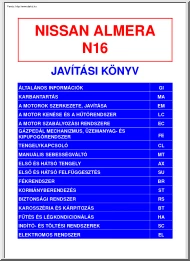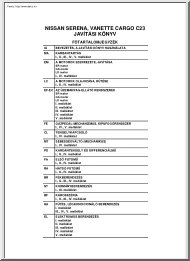Alapadatok
Év, oldalszám:2009, 5 oldal
Nyelv:angol
Letöltések száma:2
Feltöltve:2022. szeptember 26.
Méret:264 KB
Intézmény:
-
Megjegyzés:
Csatolmány:-
Letöltés PDF-ben:Kérlek jelentkezz be!
Értékelések
Nincs még értékelés. Legyél Te az első!Legnépszerűbb doksik ebben a kategóriában
Tartalmi kivonat
Patentatnt 00 Publication number: Office J E u r o p European a i s c h e Patent s 342 A1 Office europeen des brevets EUROPEAN 0 PATENT A P P L I C A T I O N intci.*: B 60 K 2 0 / 0 4 B 62 D 2 7 / 0 6 Application number: 89850148.1 Date of filing: 09.0589 @ Applicant: AB VOLVO Torslanda S-40508G6teborg (SE) Priority: 09.0588 SE 8801751 Date of publication of application: 15.1189 Bulletin 89/46 @ Inventor: Thoreson, Torsten Solskiftegatan 20 S-44253Kungalv (SE) Designated Contracting States: AT BE CH DE FR GB IT LI LU NL SE A request for correction and addition in the description has been filed pursuant to Rule 88 EPC. A decision on request will be taken during the procedings before the Examining Division (Guidelines for Examination in the EPO A-V, 2.2) @ Representative: Hellbom, Lars Olof et al H. Albihns Patentbyra AB Box 3137 S-103 62 Stockholm (SE) @ Gear shift mechanism for tilt cab vehicles. @ Agear shift mechanism for tilt cab trucks comprises a lever receiving
mounting (6) on the engine/transmission and has a ball joint (5) in the ball of which the shift lever (3) is removably received. When the cab is tilted, the lever becomes detached from the ball joint and is centred in its through-hole (2) in the cab floor or engine hood (1) by bands or wires (17) and tensile springs (15), which are fixed ortensioned between the lever and the edges of the through-hole. s CM 3 FIG.1 Q. LU Bundesdruckerei Berlin 174 EP 0 342 174 A1 Description Gear shift mechanism for tilt cab vehicles The present invention relates to a gear shift mechanism in a motor vehicle with a cab tillable relative to the vehicle chassis and engine/transmission, comprising a lever receiving mounting arranged under the cab floor or the engine hood with a bearing for a gear shift lever, which extends into the cab through a through-hole in the floor or engine hood. In trucks with front mounted tillable cabs, in which the engine is usually mounted under the cab and is covered by a
hood between the seats, the gear shift lever and associated linkages must be arranged so that they do not present an obstacle to the tilting movement. The arrangement should be such that the gear selector has distinct positions and it should only be minimally affected by the movements of the cab, which can, in todays modern trucks with comfortable spring mounted cabs, be relatively large in all directions relative to the chassis and engine/ transmission. Furthermore, the gear selector mechanism should be sealed off effectively so that a low noise level can be maintained in the cab. Finally, the gear shift mechanism should be simple and reliable and permit tilting of the cab without any additional "releasing operations". None of the solutions presented up to now fulfill all of these conditions. While it is true that gear selector mechanisms with the lever mounting fixed to the transmission usually have distinct positions and are only minimably effected by cab movements, they
have either sealing problems (in unarticulated lever designs) because the hole in the engine hood or floor must be large or they require extra blocking mechanisms for the release means (for articulated lever designs) (see for example SE 439 464). Gear shift mechanisms with the shift lever bearing joined to the cab are simpler to seal in order to keep the noise level low, but in this case the shift lever must be able to somehow be released from the rest of the shift mechanism when the cab is tilted. These mechanisms are, however, affected by cab movements with indistinct gear speed positions as a result as well as problems with the gear selector being jolted out of gear when driving on uneven surfaces. Gear shift mechanisms, in which the shift lever bearing is resiliently joined to the cab, are shown in DE 2 110 310 and US 4 269 282, for example. In both of these mechanisms, the shift lever has a spherical end portion which is normally received in an opening in the gear transfer
mechanism. This end portion is removed from this opening when the cab is tilted. The spring loaded mounting of the bearing in the cab permits limited shock absorbing movement of the cab without any problems, but large vertical cab movements or lateral movements present the risk that the spring loaded shift lever mounting housing will lose contact with its stationary support surface in the gear lever socket in the engine/transmission, resulting in play, misalignment and malfunctioning. Hard and rapid gear shifting can have the same 5 10 15 20 25 30 35 40 45 50 55 60 result. Another disadvantage is that it is not possible to provide a connection free from play between the lever and the gear transfer mechanism. In order to permit disengagement and engagement, there must be a certain amount of play between the spherical end of the lever and the complementary socket in the gear transfer mechanism. This play increases with time due to wear and produces an even larger effect at
the shift lever handle which produces indistinct gear selection. The purpose of the present invention is to remove all of the above mentioned disadvantages and provide a shift mechanism of the type described by way of introduction, which is simple and reliable, has distinct gear positions, is simple to seal off to provide low noise level inside the cab, and which does not require any additional release steps prior to tilting the cab or any engaging steps after tilting the cab back to its operating position. This is achieved according to the invention by virtue of the fact that the lever receiving mounting with associated bearing is securely mounted in the engine/transmission, that the lever is removably connected to the bearing to become detached from the bearing when there is a lever movement caused by the tilting movement of the cab, and that the lever is connected with limited mobility to the cab and, in the tilting position of the cab, is spring loaded to a defined disposition in
the through-hole in the floor or engine hood. The direct connection between the shift lever and a bearing securely joined to the engine/transmission provides distinct shift positions and negligible risk of the gear selector being jolted out of gear, since the shift mechanism is not affected by the cab movements. By placing the lever connection directly in the bearing, the lever will always be in the through-hole in the floor or engine hood regardless of the position of the cab, thus eliminating the need for separating sealing surfaces. An undivided sealing means can be used between the lever and the edges of the through-hole, thus making effective noise insulation possible. The mechanism also permits comparatively large relative movements in all directions between the cab and the engine/transmission. The cab can be tilted up or down regardless of the gear selector position. The invention will be described in more detail with reference to an example shown in the accompanying drawing,
where Figure 1 shows a partially sectioned schematic side view of the gear shift mechanism according to the invention, and Figure 2 shows a view along the line ll-ll in Figure 1. In the Figures, 1 designates a plate constituting a part of a floor or an engine hood in a truck cab and 2 is an opening forming a through-hole for a shift lever generally designated 3, which, in a manner to be described in more detail below, is connected to a ball 4 of a ball joint 5 in a lever receiving mounting 6. The mounting 6 is fixed to the vehicle engine, the transmission or some component joined thereto EP 0 342174 A1 (not shown), so that there is no relative movement between the shift lever 3 and the transmission when there is relative movement between the plate 1 and the engine/transmission, i.e during shock absorbing movements of the cab The gear shift lever 3 is made with a conical portion 7 and the ball 4 has in it a complementary cavity or socket 8, in which the conical portion 7 is received
when the cab is in its normal untilted position. The socket 8 has an upper edge portion 8a with a larger conical angle than the rest of the socket and two opposing planer surfaces 8b. The conical portion 7 of the shift lever has corresponding planer surfaces 7b, thus preventing rotation of the lever 3 relative to the ball. Below the conical portion 7, the lever has a somewhat narrower portion 9 with a pointed end 10. This is received in a tubular extension 11 of the ball 4. The extension 11 ends with a short angled arm 12, which is joined via a joint provided with a needle bearing to a shifting rod 13, connected to the gear transfer mechanism of the transmission. One end of each of a pair of tensile springs 15 is hooked near to the gear lever handle 14. The other ends of the springs are attached to individual eyes 16 in the plate 1, so that in the normal untilted position of the cab, the lever 3 is spring loaded towards the lever receiving mounting 6 and so that its conical portion 7
is held pressed without play into the socket 8. Between the lever 3 and the throughhole 12, four flexible elements 17 in the form of bands or wires are attached to a flange 18 around the through-hole 12 and in individual plates 19 welded to the lever. Figure 2 shows one of the four flexible elements 17 with associated plate 19. The anchoring points for the three other elements are designated 20. When the cab is tilted, the lever 3 is pulled upwards by the flexible elements 17 and is separated from the ball 4 of the ball joint. At the same time the springs 15 load the lever downwards and keep the elements 17 (the bands or wires) tensioned. Together with the springs, the elements 17 fix the lever 3 in a defined position in the hole 2 in the floor/engine hood 1, as indicated by the dash dot lines in Figure 1. As a result thereof, the pointed end of the lever 3 will also have a defined position in relation to the conical socket 8. The components have such dimensions that the pointed end 10
of the lever 3 is guided into the socket 8 regardless of the gear selector position, when the cab is tilted back to its normal operating position. This is achieved by virtue of the fact that the wide conical portion 8a is disposed so close to the center of rotation of the ball 4 that its position changes very little between the different gear positions. In the embodiment described above, it is possible to use an undivided sealing bellows 21 and a common sleeve covering 22 between the edge of the through-hole 2 and the lever 3. Claims 5 10 15 20 25 30 35 40 45 50 55 60 65 1 Gear shift mechanism in a motor vehicle 1. witl a cab tiltable relative to the vehicle chassis with and anc engine/transmission, comprising a lever mounting arranged under the cab rec receiving floe or the engine hood with a bearing for a floor ges shift lever, which extends into the cab gear thn through a through-hole in the floor or engine hoc characterized in that the lever receiving hood, (6) with
associated bearing (5) is mounting mo mounted on the engine/transmission, sec securely tha the lever (3) is removably connected to the that bes to be detached when there is a lever bearing caused by the tilting movement of movement me the the cab and that the lever is connected with limited limi mobility to the cab and, in the tilted of the cab, is spring loaded by spring position pos (15) to a defined disposition in the mei means thr< through-hole (2) in the floor (1 ) or engine hood. 22. Gear shift mechanism according to claim 1, chs characterized in that flexible elements (17) connect the lever (3) to the cab and that tensile cor spring means (15) are tensioned between the spr lev< lever and the cab and load the lever towards the lev( lever receiving mounting. £3. Gear shift mechanism according to claim 1 or :2, characterized in that the bearing (5) is a ball joint with a ball (4) which has a profile cavity or isocket (8), and that the lever (3) has an end portion (7), which
in the normal untilted position por of 1the cab is received in the socket and has a profiled portion fitted therein. pro A 4. Gear shift mechanism according to claim 3, characterized in that the ball (4) has a conical ch£ cav cavity or socket (8) and that the shift lever (3) has a conical portion (7) fitting into said socket. £5. Gear shift mechanism according to claim 4, chj characterized in that the conical socket (8) of the the ball (4) has an upper edge portion (8a) of larc larger conical angle than the rest of the socket and that the lever (3) has a pointed end portion am (10) (10 of larger conical angle than said conical portion of the lever. poi (. Gear shift mechanism according to one of 6. cla claims 1-4, characterized in that the lever (3) is connected to the edges of the through-hole by coi three bands or wires (17), which, in the I at least tilti position of the cab, centre the lever in the tilted thr (2) together with the spring through-hole (15). me means EP 0 342 174
A1 J > ) Category European Patent Office DOCUMENTS CONSIDERED TO BE RELEVANT Citation ot document wilh indication, where appropriate, of relevant passages Relevant to claim US-A-4 269 282 (MACK TRUCKS INC.) 1,2 US-A-4 220 217 (KUNIAKI K0BAYASHI) 1,2 (STEYR-DAIMLER-PUCH AG) 1,2 DE-B-2 A EUROPEAN SEARCH R E P O R T 110 310 DE-B-2 328 230 (DAIMLER-BENZ AG) US-A-4 (APPLIED POWER INC. 235 299 Application numbtr EP89850148.1 CLASSIFICATION OF THE APPLICATION (Inl CM) B 60 K 2 0 / 0 4 B 62 D 2 7 / 0 6 TECHNICAL FIELDS SEARCHED (Int. CMI B 60 K G 05 G B 62 D The present search report ha* been drawn up for all claims Place of search STOCKHOLM 3 3 Date of completion of the March 24-07-1989 CATEGORY OF CITED DOCUMENTS X : particularly relevant if taken alone Y : particularly relevant if combined with another document of the same category A : technological background O : non-written disclosure P . intermediate document Examiner VARNBO P - 0 T : theory or principle
underlying the invention E : earlier patent document, but published on, or after the filing date D : document cited in the application L : document cited for other reasons & : member of the same patent family, corresponding document
mounting (6) on the engine/transmission and has a ball joint (5) in the ball of which the shift lever (3) is removably received. When the cab is tilted, the lever becomes detached from the ball joint and is centred in its through-hole (2) in the cab floor or engine hood (1) by bands or wires (17) and tensile springs (15), which are fixed ortensioned between the lever and the edges of the through-hole. s CM 3 FIG.1 Q. LU Bundesdruckerei Berlin 174 EP 0 342 174 A1 Description Gear shift mechanism for tilt cab vehicles The present invention relates to a gear shift mechanism in a motor vehicle with a cab tillable relative to the vehicle chassis and engine/transmission, comprising a lever receiving mounting arranged under the cab floor or the engine hood with a bearing for a gear shift lever, which extends into the cab through a through-hole in the floor or engine hood. In trucks with front mounted tillable cabs, in which the engine is usually mounted under the cab and is covered by a
hood between the seats, the gear shift lever and associated linkages must be arranged so that they do not present an obstacle to the tilting movement. The arrangement should be such that the gear selector has distinct positions and it should only be minimally affected by the movements of the cab, which can, in todays modern trucks with comfortable spring mounted cabs, be relatively large in all directions relative to the chassis and engine/ transmission. Furthermore, the gear selector mechanism should be sealed off effectively so that a low noise level can be maintained in the cab. Finally, the gear shift mechanism should be simple and reliable and permit tilting of the cab without any additional "releasing operations". None of the solutions presented up to now fulfill all of these conditions. While it is true that gear selector mechanisms with the lever mounting fixed to the transmission usually have distinct positions and are only minimably effected by cab movements, they
have either sealing problems (in unarticulated lever designs) because the hole in the engine hood or floor must be large or they require extra blocking mechanisms for the release means (for articulated lever designs) (see for example SE 439 464). Gear shift mechanisms with the shift lever bearing joined to the cab are simpler to seal in order to keep the noise level low, but in this case the shift lever must be able to somehow be released from the rest of the shift mechanism when the cab is tilted. These mechanisms are, however, affected by cab movements with indistinct gear speed positions as a result as well as problems with the gear selector being jolted out of gear when driving on uneven surfaces. Gear shift mechanisms, in which the shift lever bearing is resiliently joined to the cab, are shown in DE 2 110 310 and US 4 269 282, for example. In both of these mechanisms, the shift lever has a spherical end portion which is normally received in an opening in the gear transfer
mechanism. This end portion is removed from this opening when the cab is tilted. The spring loaded mounting of the bearing in the cab permits limited shock absorbing movement of the cab without any problems, but large vertical cab movements or lateral movements present the risk that the spring loaded shift lever mounting housing will lose contact with its stationary support surface in the gear lever socket in the engine/transmission, resulting in play, misalignment and malfunctioning. Hard and rapid gear shifting can have the same 5 10 15 20 25 30 35 40 45 50 55 60 result. Another disadvantage is that it is not possible to provide a connection free from play between the lever and the gear transfer mechanism. In order to permit disengagement and engagement, there must be a certain amount of play between the spherical end of the lever and the complementary socket in the gear transfer mechanism. This play increases with time due to wear and produces an even larger effect at
the shift lever handle which produces indistinct gear selection. The purpose of the present invention is to remove all of the above mentioned disadvantages and provide a shift mechanism of the type described by way of introduction, which is simple and reliable, has distinct gear positions, is simple to seal off to provide low noise level inside the cab, and which does not require any additional release steps prior to tilting the cab or any engaging steps after tilting the cab back to its operating position. This is achieved according to the invention by virtue of the fact that the lever receiving mounting with associated bearing is securely mounted in the engine/transmission, that the lever is removably connected to the bearing to become detached from the bearing when there is a lever movement caused by the tilting movement of the cab, and that the lever is connected with limited mobility to the cab and, in the tilting position of the cab, is spring loaded to a defined disposition in
the through-hole in the floor or engine hood. The direct connection between the shift lever and a bearing securely joined to the engine/transmission provides distinct shift positions and negligible risk of the gear selector being jolted out of gear, since the shift mechanism is not affected by the cab movements. By placing the lever connection directly in the bearing, the lever will always be in the through-hole in the floor or engine hood regardless of the position of the cab, thus eliminating the need for separating sealing surfaces. An undivided sealing means can be used between the lever and the edges of the through-hole, thus making effective noise insulation possible. The mechanism also permits comparatively large relative movements in all directions between the cab and the engine/transmission. The cab can be tilted up or down regardless of the gear selector position. The invention will be described in more detail with reference to an example shown in the accompanying drawing,
where Figure 1 shows a partially sectioned schematic side view of the gear shift mechanism according to the invention, and Figure 2 shows a view along the line ll-ll in Figure 1. In the Figures, 1 designates a plate constituting a part of a floor or an engine hood in a truck cab and 2 is an opening forming a through-hole for a shift lever generally designated 3, which, in a manner to be described in more detail below, is connected to a ball 4 of a ball joint 5 in a lever receiving mounting 6. The mounting 6 is fixed to the vehicle engine, the transmission or some component joined thereto EP 0 342174 A1 (not shown), so that there is no relative movement between the shift lever 3 and the transmission when there is relative movement between the plate 1 and the engine/transmission, i.e during shock absorbing movements of the cab The gear shift lever 3 is made with a conical portion 7 and the ball 4 has in it a complementary cavity or socket 8, in which the conical portion 7 is received
when the cab is in its normal untilted position. The socket 8 has an upper edge portion 8a with a larger conical angle than the rest of the socket and two opposing planer surfaces 8b. The conical portion 7 of the shift lever has corresponding planer surfaces 7b, thus preventing rotation of the lever 3 relative to the ball. Below the conical portion 7, the lever has a somewhat narrower portion 9 with a pointed end 10. This is received in a tubular extension 11 of the ball 4. The extension 11 ends with a short angled arm 12, which is joined via a joint provided with a needle bearing to a shifting rod 13, connected to the gear transfer mechanism of the transmission. One end of each of a pair of tensile springs 15 is hooked near to the gear lever handle 14. The other ends of the springs are attached to individual eyes 16 in the plate 1, so that in the normal untilted position of the cab, the lever 3 is spring loaded towards the lever receiving mounting 6 and so that its conical portion 7
is held pressed without play into the socket 8. Between the lever 3 and the throughhole 12, four flexible elements 17 in the form of bands or wires are attached to a flange 18 around the through-hole 12 and in individual plates 19 welded to the lever. Figure 2 shows one of the four flexible elements 17 with associated plate 19. The anchoring points for the three other elements are designated 20. When the cab is tilted, the lever 3 is pulled upwards by the flexible elements 17 and is separated from the ball 4 of the ball joint. At the same time the springs 15 load the lever downwards and keep the elements 17 (the bands or wires) tensioned. Together with the springs, the elements 17 fix the lever 3 in a defined position in the hole 2 in the floor/engine hood 1, as indicated by the dash dot lines in Figure 1. As a result thereof, the pointed end of the lever 3 will also have a defined position in relation to the conical socket 8. The components have such dimensions that the pointed end 10
of the lever 3 is guided into the socket 8 regardless of the gear selector position, when the cab is tilted back to its normal operating position. This is achieved by virtue of the fact that the wide conical portion 8a is disposed so close to the center of rotation of the ball 4 that its position changes very little between the different gear positions. In the embodiment described above, it is possible to use an undivided sealing bellows 21 and a common sleeve covering 22 between the edge of the through-hole 2 and the lever 3. Claims 5 10 15 20 25 30 35 40 45 50 55 60 65 1 Gear shift mechanism in a motor vehicle 1. witl a cab tiltable relative to the vehicle chassis with and anc engine/transmission, comprising a lever mounting arranged under the cab rec receiving floe or the engine hood with a bearing for a floor ges shift lever, which extends into the cab gear thn through a through-hole in the floor or engine hoc characterized in that the lever receiving hood, (6) with
associated bearing (5) is mounting mo mounted on the engine/transmission, sec securely tha the lever (3) is removably connected to the that bes to be detached when there is a lever bearing caused by the tilting movement of movement me the the cab and that the lever is connected with limited limi mobility to the cab and, in the tilted of the cab, is spring loaded by spring position pos (15) to a defined disposition in the mei means thr< through-hole (2) in the floor (1 ) or engine hood. 22. Gear shift mechanism according to claim 1, chs characterized in that flexible elements (17) connect the lever (3) to the cab and that tensile cor spring means (15) are tensioned between the spr lev< lever and the cab and load the lever towards the lev( lever receiving mounting. £3. Gear shift mechanism according to claim 1 or :2, characterized in that the bearing (5) is a ball joint with a ball (4) which has a profile cavity or isocket (8), and that the lever (3) has an end portion (7), which
in the normal untilted position por of 1the cab is received in the socket and has a profiled portion fitted therein. pro A 4. Gear shift mechanism according to claim 3, characterized in that the ball (4) has a conical ch£ cav cavity or socket (8) and that the shift lever (3) has a conical portion (7) fitting into said socket. £5. Gear shift mechanism according to claim 4, chj characterized in that the conical socket (8) of the the ball (4) has an upper edge portion (8a) of larc larger conical angle than the rest of the socket and that the lever (3) has a pointed end portion am (10) (10 of larger conical angle than said conical portion of the lever. poi (. Gear shift mechanism according to one of 6. cla claims 1-4, characterized in that the lever (3) is connected to the edges of the through-hole by coi three bands or wires (17), which, in the I at least tilti position of the cab, centre the lever in the tilted thr (2) together with the spring through-hole (15). me means EP 0 342 174
A1 J > ) Category European Patent Office DOCUMENTS CONSIDERED TO BE RELEVANT Citation ot document wilh indication, where appropriate, of relevant passages Relevant to claim US-A-4 269 282 (MACK TRUCKS INC.) 1,2 US-A-4 220 217 (KUNIAKI K0BAYASHI) 1,2 (STEYR-DAIMLER-PUCH AG) 1,2 DE-B-2 A EUROPEAN SEARCH R E P O R T 110 310 DE-B-2 328 230 (DAIMLER-BENZ AG) US-A-4 (APPLIED POWER INC. 235 299 Application numbtr EP89850148.1 CLASSIFICATION OF THE APPLICATION (Inl CM) B 60 K 2 0 / 0 4 B 62 D 2 7 / 0 6 TECHNICAL FIELDS SEARCHED (Int. CMI B 60 K G 05 G B 62 D The present search report ha* been drawn up for all claims Place of search STOCKHOLM 3 3 Date of completion of the March 24-07-1989 CATEGORY OF CITED DOCUMENTS X : particularly relevant if taken alone Y : particularly relevant if combined with another document of the same category A : technological background O : non-written disclosure P . intermediate document Examiner VARNBO P - 0 T : theory or principle
underlying the invention E : earlier patent document, but published on, or after the filing date D : document cited in the application L : document cited for other reasons & : member of the same patent family, corresponding document





 Útmutatónk teljes körűen bemutatja az angoltanulás minden fortélyát, elejétől a végéig, szinttől függetlenül. Ha elakadsz, ehhez az íráshoz bármikor fordulhatsz, biztosan segítségedre lesz. Egy a fontos: akarnod kell!
Útmutatónk teljes körűen bemutatja az angoltanulás minden fortélyát, elejétől a végéig, szinttől függetlenül. Ha elakadsz, ehhez az íráshoz bármikor fordulhatsz, biztosan segítségedre lesz. Egy a fontos: akarnod kell!